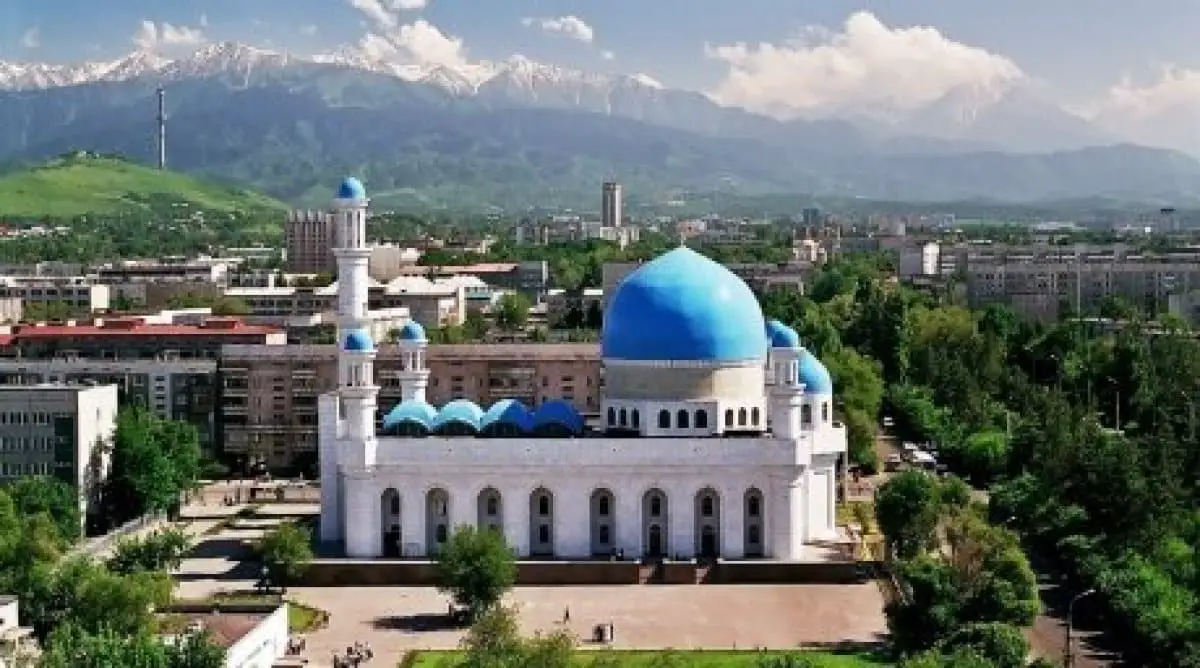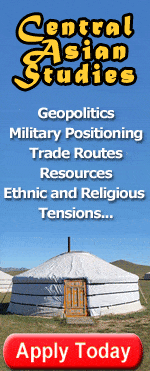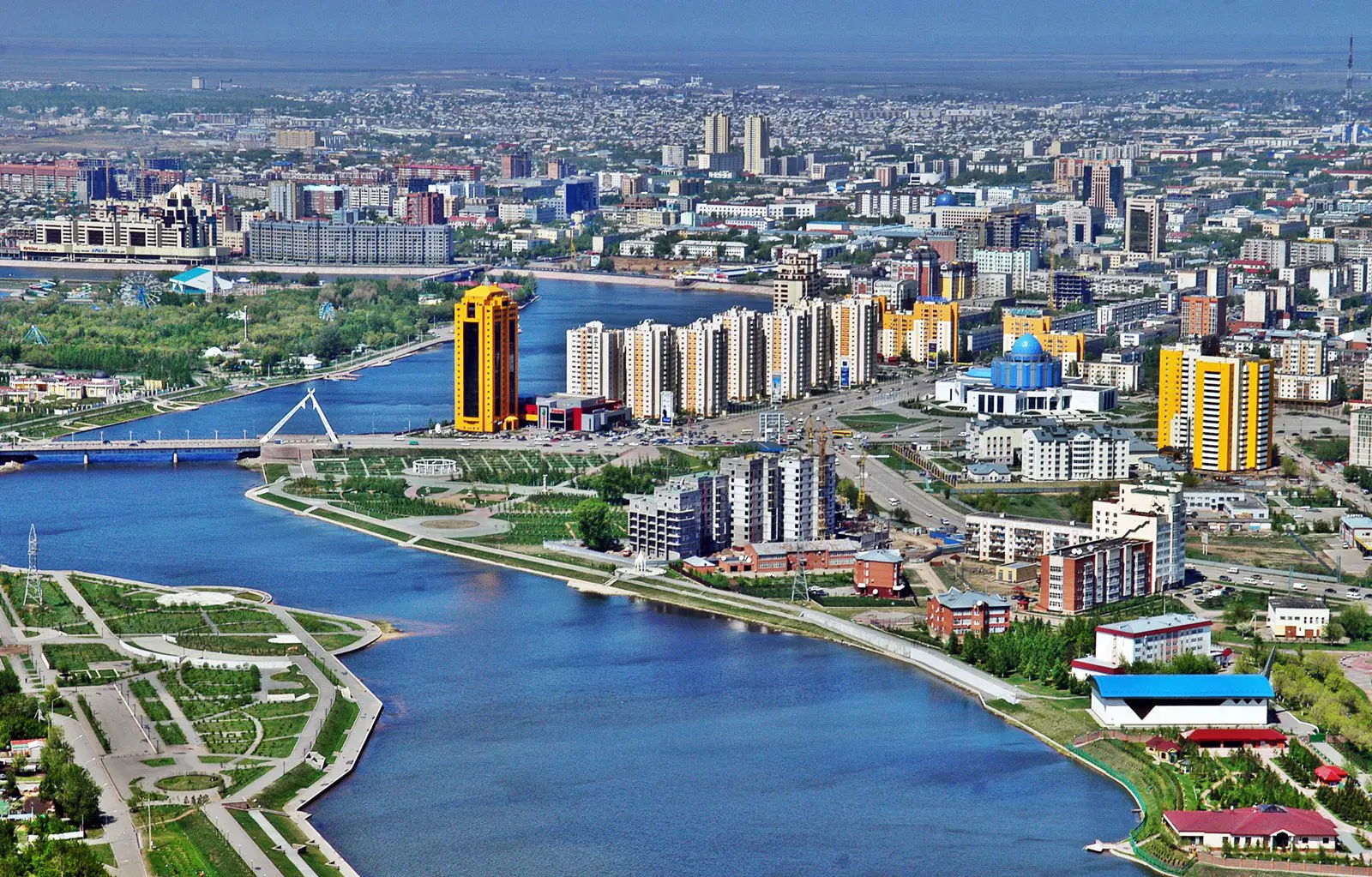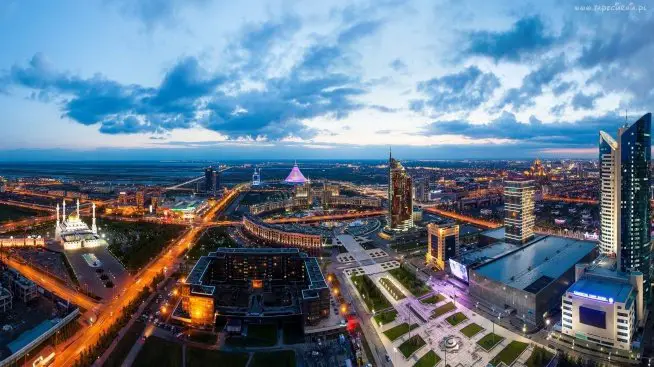I. Almaty – The Old Capital

Almaty’s Central Mosque, pictured with the city and surrounding mountains.
Almaty is a beautiful city perched among the mountains in Southern Kazakhstan. Its name comes from the Kazakh word “alma” which means “apple;” apple orchards have long surrounded the city.

The area has been inhabited since nearly the beginning of man. Archeological expeditions have uncovered artifacts such as “The Golden Man” which show the presence of an advanced society in the area as early as the 5th century B.C. These civilizations were largely nomadic, but a prosperous settlement called Almatu formed on the site to service the Silk Road perhaps 1000 to 1500 years ago.
The site became one of contention between the Russians and the Mongols.The Khan of Kokhand still claimed the area, though the Russians had managed to build a fort near Almatu in 1854 and send Cossack and Siberian settlers to populate the region. The Mongols managed to lay the fort to waste, but lost control of the city which was renamed Verny after the fort Vernoe. Russians usually date the founding of the city to the founding of the fort, much to the contention of patriotic Kazakhs.
The city was destroyed by earthquakes in 1887 and 1911 but because of its advantageous location, was always rebuilt. Settlement by the Russians continued at a fast pace, pushing the native Kazakhs out of the best tracts of land and causingeconomic hardship. After a 1916 decree forced Kazakhs into conscription, a revolt broke out, but failed because the Kazakhs had no weapons and were poorly organized. To avoid death, tens of thousands fled to China, leaving behind everything they owned. Those that remained faced brutal retribution.
After the Revolution, Verny was the center of a White Army/Cossak garrison. The Bolsheviks, however, took advantage of the area’s economic and social problems to start an uprising. They renamed the city to “Alma-Ata” which theoretically means “father of apples” in Kazakh. The meaning is only theoretical because it doesn’t follow Kazakh grammar and is likely a reflection of the Communists’ attempts to “simplify” or “Russify” native languages.
In 1929, Alma-Ata became the capital city of the newly formed Kazakh SSR. It saw great growth with the arrival of the Turksib Railway and during WWII many factories were relocated there. The city was again the site of major unrest as the Soviet Union crumbled in the 1980s and, in 1991, hosted the delegation that created the CIS, effectively destroying theUSSR. In 1994 the city was renamed Almaty, which does follow Kazakh grammar.
Although the city is no longer the political capital of Khazakhstan (an entirely new city called Atsana is now), it is still the economic capital. The population is mostly Russian and Ukranian, with several thousand foreigners (from American to Chinese and Korean) seeking economic opportunity in the booming oil town.
Central Asian Studies from SRAS
based in Bishkek, Kyrgyzstan
II. Astana – The New Capital
(section contributed by Dan Satinsky)

Astana is a nearly entirely new city – most of it built after 1994
After returning from my first business trip with a US client to Kazakhstan in April, I was a bit surprised to find that even many veteran travelers to Kazakhstan had not been to the new capital of Astana, which is quickly becoming the economic, cultural, and scientific center for a growing oil and gas power.

After Kazakhstan became independent in 1991, the city’s name was changed back to Agmola. In 1994, it was decided that the Kazakhstan’s capital would be moved from Almaty to Agmola and the city’s name was changed again in recognition of this. The new name, “Astana,” literally means “capital” in the Kazakh language. A massive building effort was launched and the city was turned into a completely planned and modern city. It officially became the capital on December 10, 1997 and, with approximately 575,000 people, is now the third largest city in the country.
The construction of the new capital has been the special project of President Nazarbayev and has variously been attributed to the need to provide a new modern image for Kazakhstan or to move the center of political power more to the center of the multi-ethnic and multi-cultural country. In any event, it is now the political center for the country.
As an outsider, it was particularly impressive to see an entirely new, planned city being constructed in the middle of the steppe in Central Asia. The architecture is impressive and the style is described in Wikipeida as “ethno-postmodernism.” I am not an expert in architectural styles, but the modernism, or post-modernism, of the buildings reminded me of some of the buildings I had recently seen in downtown Houston, another oil and gas center. The difference being that the buildings in Astana include elements of traditional Central Asian architectural style.
Alongside the new construction, on the other bank of the River Ishim, the original city is also undergoing extensive renovation, with new buildings being interspersed with the 19th and 20th century buildings that are still in place. This area is integrated into the city as a whole and seems to have a much more vigorous street life of shops, residences, museums, and cultural institutions.
The Kazakh government is now positioning itself as a friend to all of its neighbors in the cross-roads of Asia and as open to all religions of the world. For instance, in the top of the Bayterek, the tower in the center of the new city, there is a display tablet honoring all of the world’s major religions. I was told that President Nazarbayev plans to hold regular biannual convocations of all of the world’s religions to promote mutual understanding and peace.
There also seems to be a genuine commitment to use some of the growing oil and gas proceeds to diversify the future economy through government development funds. According to the website for the Khazkh Embassy in the UK, Astana is now a Special Economic Zone with geared mostly to encourage companies to purchase land, develop it, and practice business in Astana. The government has already completed construction of a fiber-optic telecommunications backbone system and plans further development of this telecommunications infrastructure. The Kazakh government has also established an E-government consortium that includes Microsoft, Intel, Cisco and IBM among its members.
The Kazakh nation itself is cosmopolitan. By religion, is divided nearly equally between Muslim and Russian Orthodox, with some Catholics, protestants, and other religions represented, including a small but active Jewish community. Ethnically, Kazakhs hold a small majority in the country, but there also many Russians, Ukrainians, and Germans (namely “Volga Germans” who immigrated to Russia under the invitation of Catherine the Great, but were then largely deported to Central Asia under Stalin). The population of Almaty is actually dominated by these three largest ethnic minority groups by upwards of 70%.
Perhaps despite this public commitment to diversity, there is no shortage of foreign criticism and controversy connected with President Nazarbayev, who was recently made President for Life in a round of otherwise liberal constitutional reforms. However, the Kazakh people I met seemed to have a deep, genuine respect for him and for the transformation that he is bringing to the country. One can look at a city like Astana as a personal monument to the President or as a visionary commitment to the construction of a new and prosperous Kazakhstan. This not a controversy that I would care to delve into, but I can say for sure that I was impressed by the energy and entrepreneurial spirit in the people I met and with the modern construction in the city of Astana.

Daniel Satinsky on the new streets of Almaty
It is dangerous to generalize based on one business trip, but it struck me that there was a distinctive Central Asian style of business culture, along with remnants of Soviet times. This makes for an interesting combination. An important aspect of the trip was the “getting to know you” visits to restaurants and cultural sites. On the surface, this is an expression of traditional Central Asian hospitality, but it was also a means to establish a personal connection. In this order of things, the personal connection precedes business discussion. In some ways, it struck me as similar to business trips to regional Russia in the early and mid nineties, where the eating and drinking established whether there was enough in common personally to be able to due business together. Also, in our visit to Astana, it is important to note that the language of communication and business was Russian, although the staff at the hotels and the airline (Air Astana) spoke English.
These business cultural habits of interaction can be significant. For most Americans, the first question is the feasibility and profitability of the business proposal, then, if it looks as though the business can go forward, it is important to strengthen the personal relationship. At least for some Kazakhs, this is the reverse order of priority, although obviously an evaluation of business proposals takes precedence once the stage of acquaintance is completed. These different frames of reference can be a barrier to mutual understanding, if not taken into account.



